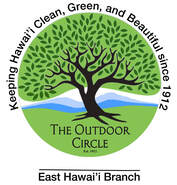Signage
Billboard-free Forever: Defending our Legacy Victory
Hawaii has a long standing tradition of regulating the size and placement of signs. In the early 1900s billboards and other inappropriate signs proliferated throughout the islands, particularly on O‘ahu. After many years of consumer actions and boycotts, The Outdoor Circle in 1926 persuaded the Territorial Legislature to pass Hawaii's law banning billboards in the islands. Today Hawaii is one of only four states that prohibit billboards. The others are Vermont, Maine and Alaska. For more detailed information about Billboards & Sign Control in the USA visit the Scenic America website:
<scenic.org/billboards-a-sign-control>
Why Regulate Signs?
Regulating signs protects the natural beauty of Hawaii. Sign regulations allow businesses and others to display important information while protecting the visual environment. Sign laws provide public safety for vehicles and pedestrians by reducing inappropriate distractions. Sign laws ensure that Hawaii remains free of all billboards.
General Sign Guidelines
Sign regulations have standards that must be followed. These standards primarily relate to size, location, placement, motion, illumination, height and setbacks. Violators may face stiff penalties including criminal charges. Sign makers and users need to check the law BEFORE creating and/or posting signs.
Complaints About Signs
Persons who believe specific signs might be in violation of State or County regulations should double check the standards before making a complaint. When making a complaint be sure to have an address where the sign is located and a detailed description of the sign in question.
Note: The Outdoor Circle does not have authority to issue citations.
County Department of Planning and Permitting (DPP)
East Hawai`i: Aupuni Center, 101 Pauahi Street, Suite 3, Hilo, HI, 96720
(808) 961-8288| Fax: (808) 961-8742
Hawaii has a long standing tradition of regulating the size and placement of signs. In the early 1900s billboards and other inappropriate signs proliferated throughout the islands, particularly on O‘ahu. After many years of consumer actions and boycotts, The Outdoor Circle in 1926 persuaded the Territorial Legislature to pass Hawaii's law banning billboards in the islands. Today Hawaii is one of only four states that prohibit billboards. The others are Vermont, Maine and Alaska. For more detailed information about Billboards & Sign Control in the USA visit the Scenic America website:
<scenic.org/billboards-a-sign-control>
Why Regulate Signs?
Regulating signs protects the natural beauty of Hawaii. Sign regulations allow businesses and others to display important information while protecting the visual environment. Sign laws provide public safety for vehicles and pedestrians by reducing inappropriate distractions. Sign laws ensure that Hawaii remains free of all billboards.
General Sign Guidelines
Sign regulations have standards that must be followed. These standards primarily relate to size, location, placement, motion, illumination, height and setbacks. Violators may face stiff penalties including criminal charges. Sign makers and users need to check the law BEFORE creating and/or posting signs.
Complaints About Signs
Persons who believe specific signs might be in violation of State or County regulations should double check the standards before making a complaint. When making a complaint be sure to have an address where the sign is located and a detailed description of the sign in question.
Note: The Outdoor Circle does not have authority to issue citations.
County Department of Planning and Permitting (DPP)
East Hawai`i: Aupuni Center, 101 Pauahi Street, Suite 3, Hilo, HI, 96720
(808) 961-8288| Fax: (808) 961-8742
Campaign Signage Laws and Recommendations
What the law says:
• Hawai'i law prohibits the placement of political signs on any public property, including median strips, sidewalks, fences and rights of way. Officials will issue citations for and/or remove any signs posted on public property.
• There are no laws regulating the size or number of signs placed on private properties, which include businesses and residences. Signs are legal on private property year-round and for any duration of time.
What the Outdoor Circle recommends:
• Each sign displayed should be no larger than 4 feet by 2 feet, and the total area of all signs for each private property should not exceed 16 square feet.
• No campaign signs should be illuminated by any form of artificial lighting.
• No sign should be erected more than 45 days before the day of the election, and all signs should be removed by 10 days after the election.
• Hawai'i law prohibits the placement of political signs on any public property, including median strips, sidewalks, fences and rights of way. Officials will issue citations for and/or remove any signs posted on public property.
• There are no laws regulating the size or number of signs placed on private properties, which include businesses and residences. Signs are legal on private property year-round and for any duration of time.
What the Outdoor Circle recommends:
• Each sign displayed should be no larger than 4 feet by 2 feet, and the total area of all signs for each private property should not exceed 16 square feet.
• No campaign signs should be illuminated by any form of artificial lighting.
• No sign should be erected more than 45 days before the day of the election, and all signs should be removed by 10 days after the election.
Guide to Signage Brochure
| hawaii_county_signage_laws.pdf |
State Signage Laws
| state_signage_laws.pdf |
